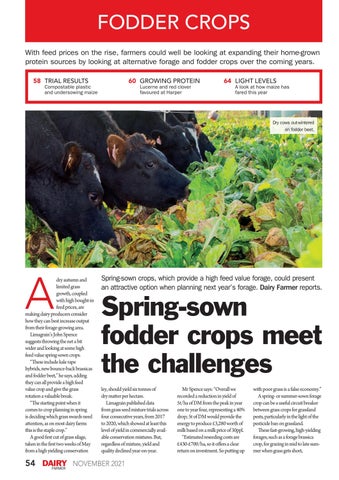FODDER CROPS With feed prices on the rise, farmers could well be looking at expanding their home-grown protein sources by looking at alternative forage and fodder crops over the coming years. 58 TRIAL RESULTS
60 GROWING PROTEIN
Compostable plastic and undersowing maize
Lucerne and red clover favoured at Harper
64 LIGHT LEVELS
A look at how maize has fared this year
Dry cows out-wintered on fodder beet.
A
dry autumn and limited grass growth, coupled with high bought-in feed prices, are making dairy producers consider how they can best increase output from their forage-growing area. Limagrain’s John Spence suggests throwing the net a bit wider and looking at some high feed value spring-sown crops. “These include kale rape hybrids, new bounce-back brassicas and fodder beet,” he says, adding they can all provide a high feed value crop and give the grass rotation a valuable break. “The starting point when it comes to crop planning in spring is deciding which grass swards need attention, as on most dairy farms this is the staple crop.” A good first cut of grass silage, taken in the first two weeks of May from a high yielding conservation
54
Spring-sown crops, which provide a high feed value forage, could present an attractive option when planning next year’s forage. Dairy Farmer reports.
Spring-sown fodder crops meet the challenges ley, should yield six tonnes of dry matter per hectare. Limagrain published data from grass seed mixture trials across four consecutive years, from 2017 to 2020, which showed at least this level of yield in commercially available conservation mixtures. But, regardless of mixture, yield and quality declined year-on-year.
Mr Spence says: “Overall we recorded a reduction in yield of 5t/ha of DM from the peak in year one to year four, representing a 40% drop; 5t of DM would provide the energy to produce £3,280 worth of milk based on a milk price of 30ppl. “Estimated reseeding costs are £430-£700/ha, so it offers a clear return on investment. So putting up
with poor grass is a false economy.” A spring- or summer-sown forage crop can be a useful circuit breaker between grass crops for grassland pests, particularly in the light of the pesticide ban on grassland. These fast-growing, high-yielding forages, such as a forage brassica crop, for grazing in mid to late summer when grass gets short,
NOVEMBER 2021
DF Nov p54 56 57 Spring-sown KJ MB.indd 2
15/10/2021 12:05
